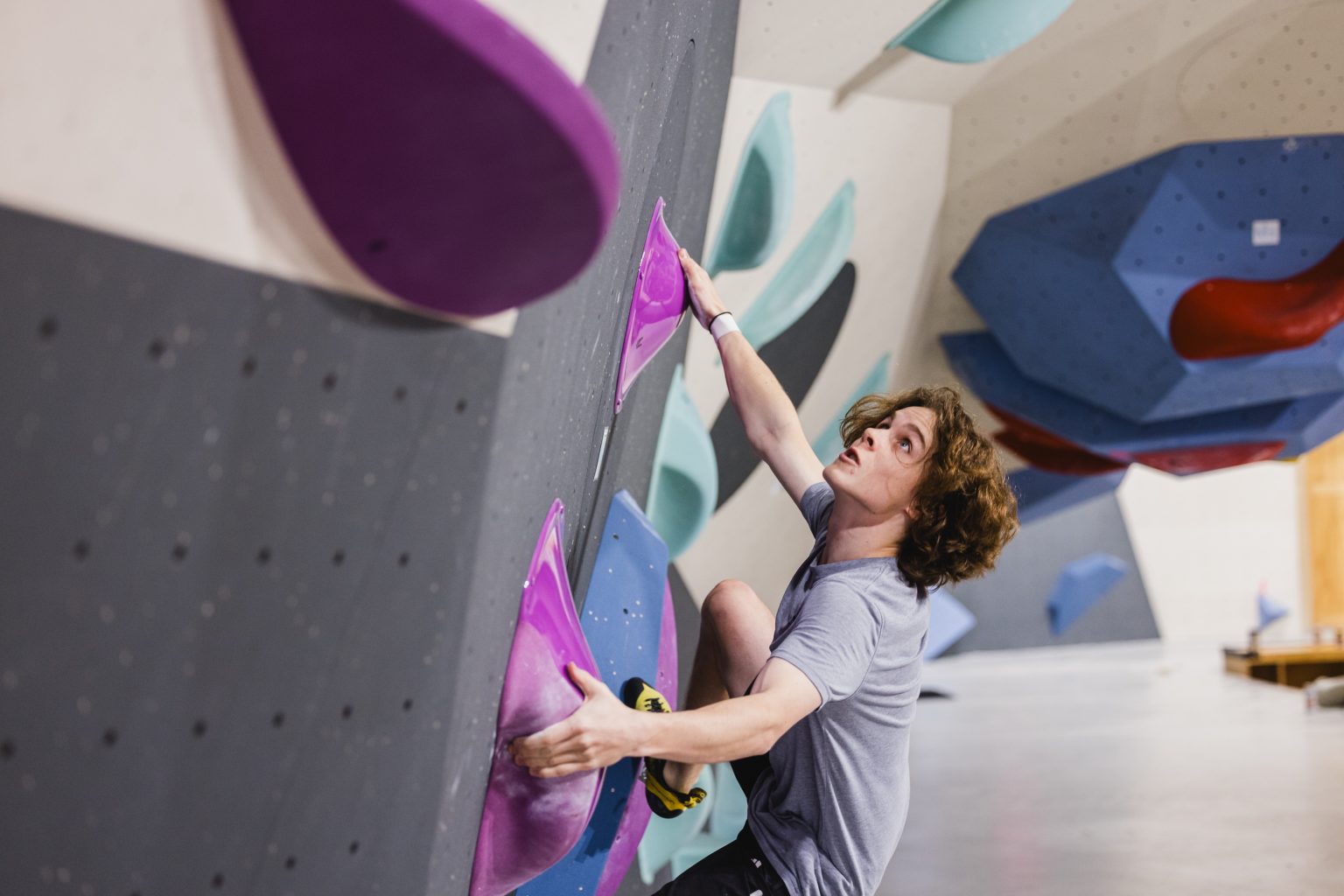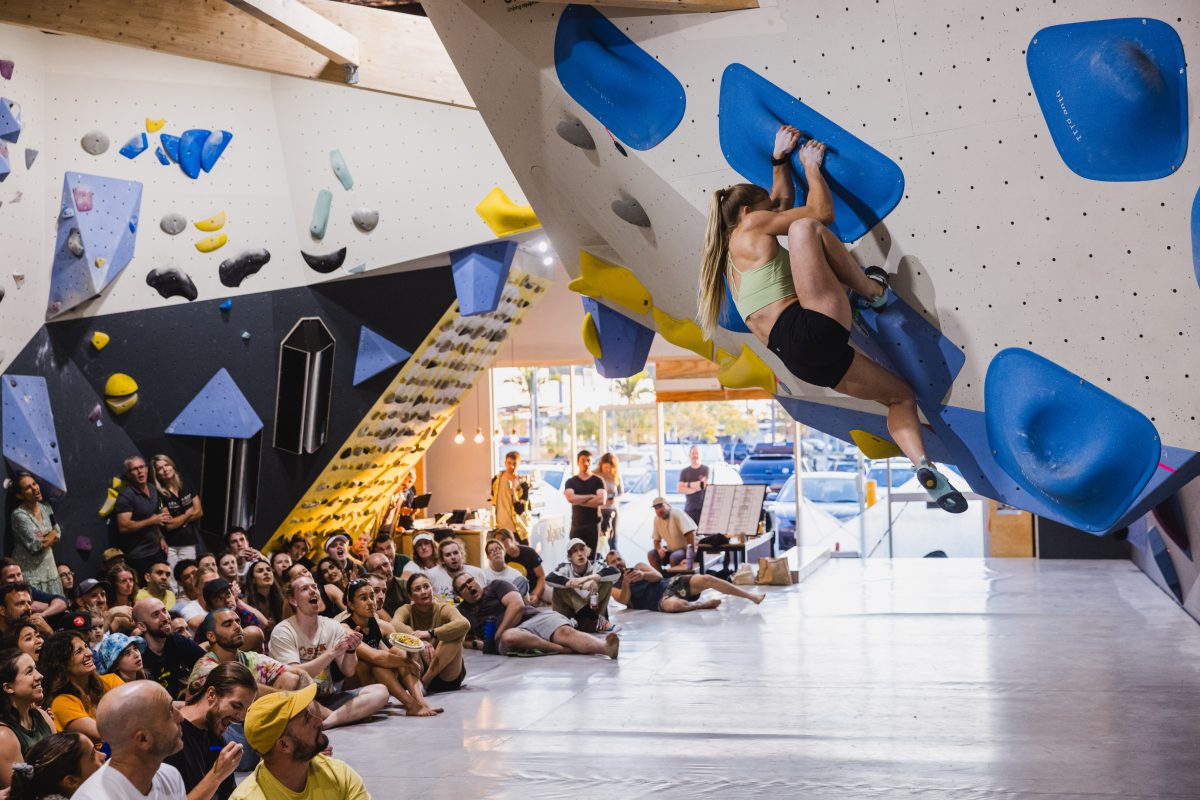Tips for Comp Climbing

This is it… the send attempt! The crowd cheers as you chalk up and latch the start holds. Breathing in you begin to flow through the puzzle of moves, aware the timer is quickly running out. The tension builds until you are a move from the finishing jug, the crowd erupts, prompting you to pull hard and latch onto it. A smile fills your face as you match on the jug – off to the next round you go! This is a slice of what the competitive climbing world feels like; far removed from your weekly hangboard routine or outdoor adventure – but equally as fun and challenging.
From social competitions, to qualifiers to a high-intensity World Cup, there are a bunch of different competition formats to be found. But, what is consistent across all is a set ‘time limit’ for each route or problem. This added time pressure means your usual approach to climbing just won’t work – instead you’ll need to implement some comp-specific beta. Here are some tips to get you started!
1. Take a Step Back
It’s easy to run out to a problem – with the clock ticking – and begin giving it burns, but this isn’t the most efficient method for topping a bloc. If you watch any professional competitive climber, you’ll notice that most take a moment before their first attempt to inspect the problem. So before you begin throwing down, take a big step back, and try visually rehearsing the beta you think will work.
This will help you approach the problem with a clearer understanding of the moves, plus it gives you a moment to assess the hold types and layout on the wall. It helps to ‘mime’ the moves out, so you can begin to memorise the beta and understand the setters style. Don’t try to race the timer, instead make every attempt count by spending a brief moment examining the problem before you try it!

2. Learn a New Language
If you are lucky enough to have chalky holds, you will be able to gain some more information by doing what’s called “Route Reading”. This process starts by simply examining the route, and piecing together the moves you think will work. It helps to envision how the route setter would have intended the problem to be climbed, rather than simply trying to take the most direct line. Ask yourself questions such as “Can I see the crux?”, “Is that move dynamic or static?” and “What will my body position be like?”. It is a massive advantage if you know the setters style, as you can account for this when climbing the problem.
An invaluable tool for competitive climbers is being able to decipher beta from simple chalk marks on holds or volumes. A chalky thumb will leave a distinct dot on a hold, so we can easily understand whether that hold is for the left or right hand (or a match).
Even if the chalk marks are faint, they can give away some finer details about a problem’s intended beta.
3. Rest
Rest is the foundation of performance, but in the heat of competition climbers often fall into the trap of trying to cram in as many attempts as possible on a problem. Anxious about losing precious time, they attempt try after try, and quickly begin to fatigue. The problem suddenly feels way harder, their high-point doesn’t increase and technique takes a nose-dive. This is where prioritising rest really shines through.
Would you rather 10 average attempts on a problem, or 3 great ones? Think about that question for a moment. Instead of falling off and immediately hopping back on, take a moment to shake-out, breath and compose yourself. Yes, you are burning time, but you’ll be climbing at a higher level because you took the time to rest. Most likely, you’ll have another boulder to try after this one, so treat it as an endurance exercise and preserve yourself. If the beta is straight-forward but the moves are incredibly hard, try resting for an extended period of time – that way you’ll be able to give 100% on your next attempt.

4. Stay Calm, Stay Focused
Above all, becoming a good comp climber is less about how you climb on the wall and more about how you perform under pressure. The competition atmosphere of cheering crowds, bright lights and camera flashes is far removed from your weekly gym session – so be prepared for some butterflies. The ability to stay calm in this scene will put you above the competition, as a calm climber is generally more focused and efficient when climbing. Use breathing techniques and mental training to teach yourself how to tune out your surroundings when under pressure and simply enjoy the climbing!
The key word here is ‘enjoy’. No matter what, make sure you are having fun – that way you’ve always won. Some people are inherently competitive while others simply aren’t, regardless, make sure you’re keeping a healthy mindset about the upcoming event. Whether you make podium or can’t send a single problem, keep things light and enjoy the comp-vibes (we guarantee you’ll climb better for it).
We trust these tips, although simple, will help you to climb at your best and have fun at your next competition.
The Alpine Games 2024
Get ready for the most anticipated climbing event of the year! The Alpine Games is a social competition that brings our community together, and this year promises to be bigger than ever. With qualifiers running over five weeks at Alpine Robina and Currumbin, you’ll face epic challenges set by our route setters. Find out all the details of our Members Only Competition here.